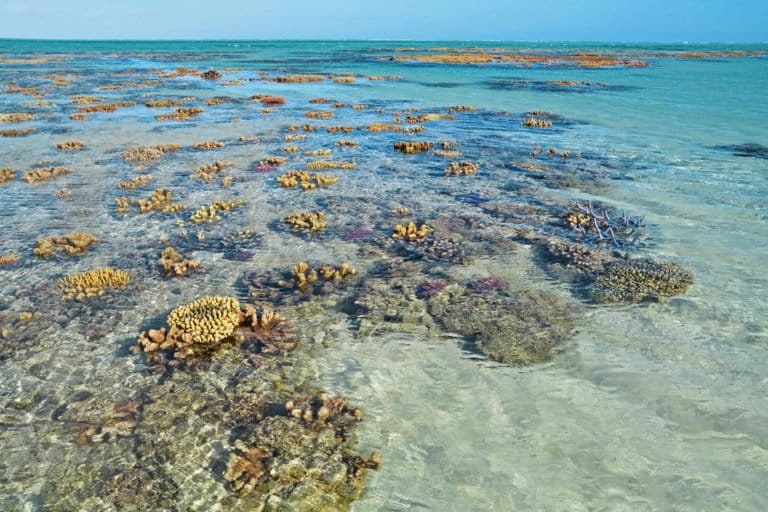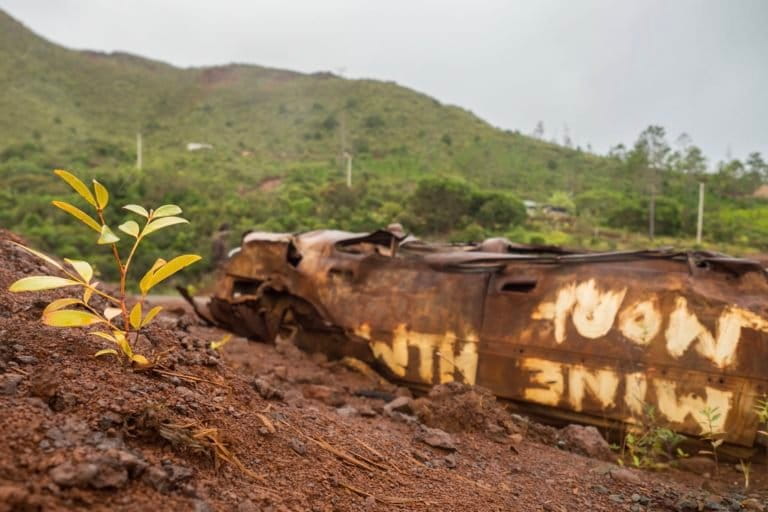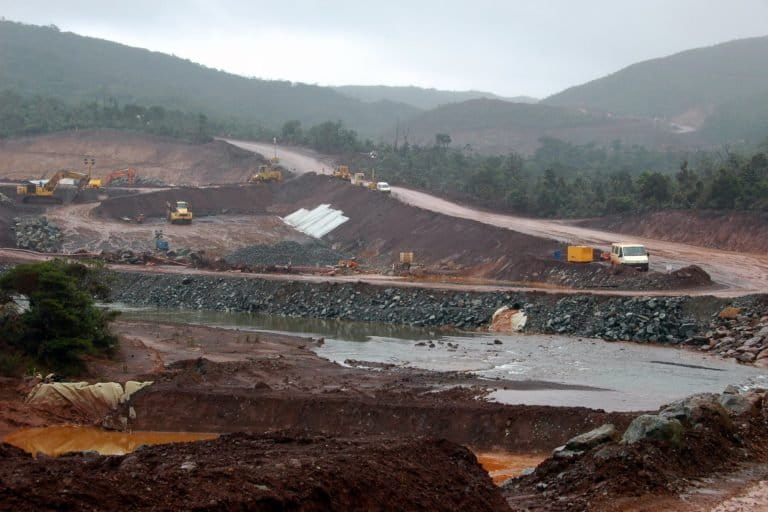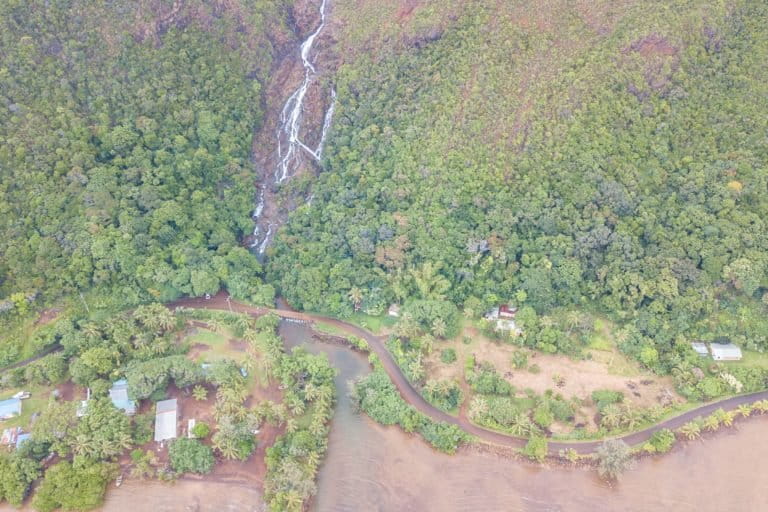All eyes on Tesla as it invests in a troubled nickel mine
- American manufacturing giant Tesla invested in New Caledonia’s Goro mine in 2021, raising local expectations that international scrutiny and the mine’s new owners could help the plant overcome past environmental mismanagement issues and social woes.
- Since 2010, there have been five recorded acid leaks at the Goro mine into nearby bays and reefs. The mine is also related to Indigenous Kanak struggles for sovereignty over its resources and violent protests in 2020.
- The mine was bought by Prony Resources, whose shares are largely owned by New Caledonian stakeholders, including local communities. Kanaks now see themselves as stakeholders and watchdogs in the mine’s production.
- Local organizations and researchers plan to keep a close eye on the environmental impacts of mining in New Caledonia, especially as Prony Resources proposes a new waste management process and China lays out its interests in the region.
GORO, New Caledonia — On the south side of Grand Terre, the largest and principal island of New Caledonia in the south Pacific, mountains rise like a spine out of a vast, turquoise lagoon that forms part of the longest continuous barrier reef in the world.
Although a French overseas territory, New Caledonia—located approximately 1,470 kilometers (900 miles) northeast of Brisbane, Australia—has been home to the Indigenous Kanak people for thousands of years and has a history and culture as rich as its ecology.
“Most of the vegetation we have in the south of the island is endemic and it is a region that contains many of our medicinal plants,” said Raphaël Mapou, a Kanak leader and head of a local environmental organization, Rhéébù Nùù. “The legends of the Kanak people speak of the importance of rivers [and] the ocean. The coral reef is a very important source of food for Kanaks.”

Just a few short miles from the famous lagoons, lies a vast, sprawling, open-cut nickel mine. Known locally as Goro, named after a nearby town, this pit and its processing plant are proving to be a stress test for a country that is thought to contain a quarter of the world’s known nickel reserves.
As the mine receives new owners and investors, including manufacturing giant Tesla, Kanak people and environmentalists are poised to see whether they can handle the mine’s troubled record.
Ecological and financial difficulties have plagued Goro since it began production in 2010 under its former owner, the Brazilian mining giant, Vale. In the past decade, there have been five chemical spills, causing fish deaths and contamination. For Kanaks, mining is also deeply tied to desires for sovereignty and local autonomy over their resources.
Daniel Goa, the leader of the territory’s largest independence party, declared in 2019 the need for New Caledonia to “take back control of [its] natural resources and key sectors controlled currently by French multinational companies” to ensure a more equitable distribution of wealth through the exploitation nickel.
Two years later, Goro was sold to Prony Resources—a locally-led consortium—and received investment from Tesla. With over half of Prony Resources’ shares owned by New Caledonian stakeholders, including local communities, local Kanaks now see themselves as stakeholders and watchdogs in the mine’s production.
Within its battery supply chain, Goro is Tesla’s sole relationship with a direct supplier in the Pacific region.
The move by Tesla to enter into a “technical and industrial partnership” with Prony joins the global pivot away from fossil fuel production toward lithium-ion battery storage for electric vehicles. Lithium-ion batteries needed for the ‘clean‘ energy transition depend heavily on nickel mining—which is anticipated to grow.

With such a significant international name attached to the mine, and the type of scrutiny this could bring by environmental and human rights organizations, there is hope among Kanak activists and community members that extra environmental protections and further employment opportunities for Indigenous workers is forthcoming.
Others, who recall the mine’s environmental record and violent protests, are more wary.
Nickel: a conflicted history
France has been mining nickel in New Caledonia since the mid-19th century. The resource is so pivotal to the local economy that it is one of the territory’s key sources of income.
New Caledonia has a GDP per capita comparable to the European Union. However, while both the territory and France have historically benefited greatly from mineral exports, there are still ongoing disputes surrounding the recognition of Kanak customary or traditional lands and the financial benefits that flow from it.
The official Kanak unemployment rate sits close to 40% amid an island of plenty, forming one of the key sources of local resentment against the current management of mines and Goro.
In recent years, royalty payments from nickel companies to Kanak communities have been discouraged by provincial governments in New Caledonia, with mining money instead invested in enterprise and business ventures within these areas as an economic development strategy.

The French territory has experienced a long-running and, at times, violent independence struggle over the last fifty years. Of the territory’s three provinces, only the south—where both Goro and the capital, Nouméa, are located—retains a French-loyalist local government. In three referendums to secede from France, the Kanak vote has overwhelmingly favored independence.
Recent independence voting has been highly contentious and the Goro issue is seen to fuel simmering tensions.
According to Séverine Bouard, a geographer and agronomist at the New Caledonian Agronomic Institute where she leads the “Territories, Actors and Uses” research team, the establishment of the Goro nickel plant was highly political from the start.
“Goro was established at the turn of the millennium, just before another plant in the north of New Caledonia called Koniambo was established,” she told Mongabay. “Koniambo was backed by the Kanak community and the pro-independence movement, as the project was intended to contribute to the territory’s economic independence and to recover some sovereignty over the management of mineral resources.”
In 2020, after years of financial woes, Vale attempted to sell the mine to Swiss company Trafigura. Counter attempts made by a local firm to purchase the mine were twice rejected by Vale and dismissed by the French overseas ministry. In December that year, violent protests erupted in Nouméa and around Goro, where access to the mine was blocked and cars torched in anger. The shells of burned-out vehicles still dot the road to the mine today.

In response to the violence, an alternative deal was brokered, which saw the newly-established and majority locally-owned Prony Resources successfully taking on the plant from Vale.
Fifty-one percent of Prony’s shares are now owned by New Caledonian stakeholders, including Prony Resources employees and local Kanak communities, with Trafigura now owning just 19% of the operation. The remaining 30% is split between Prony Resources management and the international investment firm Agio Global.
Prony promises local investment and social license, particularly for the local Kanak people who are now, in essence, stakeholders in the mine’s production.
A chequered environmental record to beat
After a decade of ongoing negotiation, production at the mine only began in 2010, with certain conditions requested by local environmental watchdog, Rhéébù Nùù, including the formation of an environmental committee to provide recommendations and commission investigative reports.
One of the key actions that Rhéébù Nùù undertook was to prevent the installation of a pipe transporting waste products, including dissolved metals, into the Havanna Canal where local people fish. This protest action helped to elevate the safety and health of the reef as a key issue of concern for local environmentalists and Kanak communities.

A key concern with any form of mining is managing the waste, or tailings, created during the extraction process. If a pipeline transporting waste isn’t installed, a tailings dam can be constructed. Significant planning and management is required to prevent leakages and, in very serious cases, even the total collapse of such a storage dam wall. Goro’s tailings dam reportedly contains about 40 million tons of residue.
In the decade since Vale began mining production at Goro, there were five recorded acid leaks. These raised the alarm for contamination of local drinking water and damage to the surrounding coral reefs. Notably, in 2014, a spill contaminated the nearby North Bay Creek, killing about 1,000 fish.
According to Vale’s annual sustainability report published that year, there were no lasting impacts to the environment or nearby Indigenous communities.
Kanak organizations, such Rhéébù Nùù, are still awaiting commissioned reports that examine the ongoing effect this has had on the marine environment and human health.
Mapou of Rhéébù Nùù believes the full effect of Vale’s operations—particularly around the acid spills—is yet to be seen.
New Caledonia’s has one of the largest marine parks on earth and takes in the ocean surrounding the Goro refinery project. Its coral systems are also recognized as a UNESCO World Heritage site.
The leaks were linked to the use of high-pressure acid leaching (HPAL) techniques. Severine Bouard explains that instead of solely utilizing heat and pressure, various chemicals are added in HPAL which can lead to the leaking of toxic materials. At Goro, the laterite soils, which are rich in iron oxide, have a lower composition of nickel. This means that new techniques for extracting the ore through chemical processing must be developed, which eventually leads to dumping and storage of waste potentially toxic to ecosystems.

“The ore in the soil near Koniambo is more concentrated than at Goro, which allows the use of pyrometallurgy techniques that have long been mastered [although they] are highly greenhouse gas emitting,” she said.
Mapou launched Rhéébù Nùù partly in response to the proposed use of HPAL at Goro and the threat leaked contaminants pose to the reef. Kanak environmental activists feared since the beginning that this new technology would present negative risks when stored as waste.
“We were especially fearful about the impact of the mine and plant facilities on forests and the marine environment and the consequences of acid spills,” says Mapou.
Fears about Vale’s ability to continue safely managing Goro were heightened by significant dam collapses in Brazil during its tenure of Goro.
In particular, the Fundão dam collapse in 2015 caused substantial environmental damage, pouring 50 million tons of ore and toxic waste into Brazil’s Rio Doce, polluting the river and croplands. Nineteen people died in what became Brazil’s worst environmental disaster.
Vale did not respond to Mongabay’s request for comment at the time of publication.

The accumulation of acid wastes requires another facility to be constructed to secure the tailings, with particular concerns raised about the proximity of the mine to the watershed.
“Perhaps the most pressing concern [with waste management] is the hydrological system,” said Severine Bouard. She explained that if there is an acid leak, then it can be carried through the transfer of water and affect the surrounding ecology. As contaminated water moves through the environment, it spreads out and there can be very significant impacts, she added.
Vale’s legacy weighs heavily over the Goro mine and locals are waiting to see if Prony Resources can handle the waste management process.
Prony Resources plans to address this pressing concern through a project dubbed “Lucy,” a technical process that dries the wet residue of the acid waste used in the mining process.
Prony claims that the Lucy process reduces the chemical concentration of mining residue by keeping the stored process water to a minimum. Prony states that this “mitigates the level of risk” associated with dam technology and will also reduce the need for further land clearing, supporting habitat and the area’s biodiversity.
Prony Resources did not respond to Mongabay’s requests for a comment at the time of publication.

Fanny Houlbreque, a research scientist on tropical corals at HDR-UMR Entopie, Institute of Research and Development, said that open-cast mining on hilltops in New Caledonia also resulted in major landscape and habitat alteration. Natural soil erosion has increased and, through nickel mining like at Goro, metals have spilled into the coral reef lagoon.
New Caledonia’s tropical weather and constant trade winds can move large amounts of sediment into the reef. This can result in increased water turbidity, with waters clouded by sediments and enriched by metals impacting coral health.
“Fringing reefs are especially sensitive to such an increase in sediment deposit and decrease in light penetration,” she said.
For Mapou, what is essential is that the local Kanak people will be able to have a say in whatever occurs in order to keep their lands safe.
“In the new project [at Goro], we are stakeholders and therefore actors,” he said. “My hope is that, through daily monitoring, we will obtain objective answers on the environment and that this chemical plant will be fully controlled.”
Many interests at stake
“New Caledonia is a regional leader [in the Pacific] on social issues, but this is only because we have strong public policies,” Bouard said. “You look at the policies around Indigenous rights acknowledgments in New Caledonia and you see that unionization is quite strong. In terms of local employment, Prony has said that they will employ thousands of local workers.”
Bouard says she’s confident Prony’s purchase and Tesla’s investment in Goro may produce positive outcomes for both the community and the environment.
Though Houlbreque warns that while the increase in mining operations is a boon for the local economy, it “represents a certain risk for the environment.”

Tesla’s head office did not respond to Mongabay’s requests for a comment at the time of publication.
In the company’s most recent annual environmental, social and governance impact report, Tesla says that it designed an approach for ethical mining which centers on two pillars: direct sourcing from mining companies and direct local engagement with communities affected by mining.
Kanak communities are not the only ones watching Tesla’s moves, the manufacturing giant is also wading into a territory with heavy-weight players and interested observers. In 2010, the year Goro started operations, China bought just 4% of New Caledonia’s exports. In 2020, the number grew to 57%. Most of the world’s electrical vehicle batteries are produced in China, which has become pivotal to the New Caledonian economy.
In recent years, China identified New Caledonia’s vast Exclusive Economic Zone (EEZ), the swathe of surrounding ocean and seabed around New Caledonia, as a key source of cobalt nodules, intrinsic, like nickel, to battery production. This is thought to share the same richness in rare earth metals as the land above.

China’s increasing presence in the region has triggered a response from the French government. During negotiations for the sale of Goro in 2020, the French state reportedly vetoed an offer from a Chinese-owned company.
In July 2021, French president Emmanuel Macron spoke of his country’s support for its Pacific territories while condemning “hegemonic powers who will come to seek [the Pacific’s] fish, their technology, their economic resources.”
Through its overseas territories, namely New Caledonia, France has the largest EEZ in the world.
The Chinese foreign ministry visited eight Pacific nations in May, a move widely seen as an economic maneuver for resources. While the list included Papua New Guinea, Fiji, Vanuatu and the Solomon Islands, fellow Melanesian state New Caledonia was notably absent.
As this international competition over resources near and around New Caledonia plays out, Kanak people and civil society organizations plan to hold whoever pursues mining in the territory to account.
“We are preparing the new generation to live up to environmental and civilizational challenges,” Mapou said. “I can say that today’s young people, young Kanak leaders, will never allow accidents such as the chemical spills that the plant has had in the past.
“We will follow every step, everything that happens.”

See related interview with Kanak leader Raphaël Mapou about nickel, Tesla and two decades of environmental activism, here.





No comments:
Post a Comment